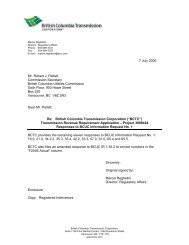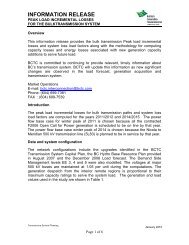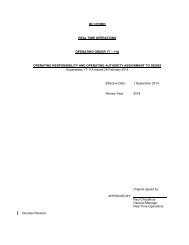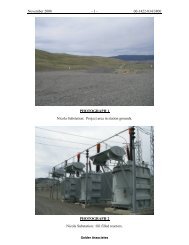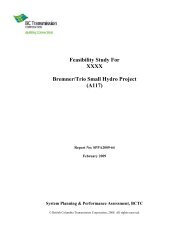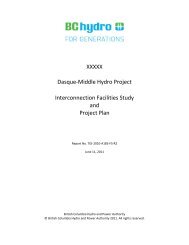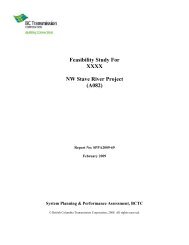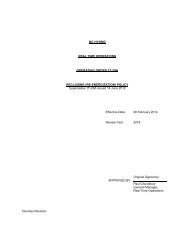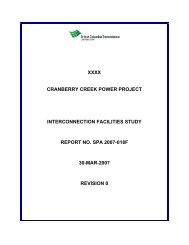Evidence on the Adequacy of First Nations Consultation - BC Hydro ...
Evidence on the Adequacy of First Nations Consultation - BC Hydro ...
Evidence on the Adequacy of First Nations Consultation - BC Hydro ...
You also want an ePaper? Increase the reach of your titles
YUMPU automatically turns print PDFs into web optimized ePapers that Google loves.
DRAFT REPORT: Rights and Title Interests in <strong>the</strong> Columbia Valley Transmissi<strong>on</strong> Project Area<br />
which was formerly classified within <strong>the</strong> Alg<strong>on</strong>kin-Wakashan group, is now c<strong>on</strong>sidered to be a<br />
language isolate <strong>on</strong> <strong>the</strong> Plateau. 248 Numerous o<strong>the</strong>r scholars have also identified Kutenai as a<br />
linguistic isolate. For example, Horatio Hale, who served as ethnologist with <strong>the</strong> United States<br />
Exploring Expediti<strong>on</strong> which explored parts <strong>of</strong> <strong>the</strong> Oreg<strong>on</strong> Territory in 1841, c<strong>on</strong>cluded that<br />
“Kitunha” [Kutenai] was <strong>on</strong>e <strong>of</strong> <strong>the</strong> languages he encountered which could not be grouped with<br />
any o<strong>the</strong>rs into a language family. 249 And J.W. Powell’s 1891 classificati<strong>on</strong> and map <strong>of</strong> <strong>the</strong><br />
Native languages <strong>of</strong> North America north <strong>of</strong> Mexico also classified “Kitunahan” as an isolate. 250<br />
More modern studies which classify Kutenai as a linguistic isolate include Voegelin and<br />
Voegelin (1977) 251 and Goddard (1996). 252 Notwithstanding, linguist Lawrence Morgan, who<br />
has studied <strong>the</strong> Kutenai language since <strong>the</strong> late 1960s and whose Master’s <strong>the</strong>sis and Doctoral<br />
dissertati<strong>on</strong> are both <strong>on</strong> this language, is <strong>of</strong> <strong>the</strong> opini<strong>on</strong> that “Kutenai is remotely and genetically<br />
related to <strong>the</strong> Salishan languages.” 253<br />
Two major social divisi<strong>on</strong>s <strong>of</strong> Kutenai — “Upper Kutenai” and “Lower Kutenai” — are<br />
recognized. These distincti<strong>on</strong>s, which corresp<strong>on</strong>d with two slightly divergent dialects <strong>of</strong> <strong>the</strong><br />
Kutenai language, are made with reference to <strong>the</strong> course <strong>of</strong> <strong>the</strong> Kootenay River. Upper Kutenai<br />
is spoken al<strong>on</strong>g <strong>the</strong> upper course <strong>of</strong> <strong>the</strong> Kootenay River both in British Columbia and M<strong>on</strong>tana,<br />
whereas Lower Kutenai is spoken al<strong>on</strong>g this river’s lower course, both in B.C. and Idaho. 254 The<br />
dividing line between Lower and Upper Kutenai has been identified as Kootenai Falls, near<br />
Troy, M<strong>on</strong>tana. 255<br />
248 Michael K. Foster (1996). Language and <strong>the</strong> Culture History <strong>of</strong> North America. Handbook <strong>of</strong> North<br />
American Indians, Vol. 17, Lanugages (ed. by Ives Goddard). Smiths<strong>on</strong>ian Instituti<strong>on</strong>: Washingt<strong>on</strong> DC. Page 81.<br />
249 Horatio Hale (1846). Ethnography and Philology. Narrative <strong>of</strong> <strong>the</strong> United States Exploring Expediti<strong>on</strong><br />
During <strong>the</strong> Years 1838, 1839, 1840, 1841, 1842. Vol. 6. :535). Lea & Blanchard: Philadelphia. Page 535.<br />
250 John Wesely Powell (1891). Indian Linguistic Families <strong>of</strong> American North <strong>of</strong> Mexico [with map]. In, 7 th<br />
Annual Report <strong>of</strong> <strong>the</strong> Bureau <strong>of</strong> Ethnology for <strong>the</strong> Year 1885-1886. Washingt<strong>on</strong>. Pp. 1-142.<br />
251 Charles F. Voegelin and Florence M. Voegelin (1977). Classificati<strong>on</strong> and Index <strong>of</strong> <strong>the</strong> World’s<br />
Languages. Elsevier: New York, Oxford and Amsterdam. Page 209.<br />
252 Ives Goddard (1996). Introducti<strong>on</strong>. Handbook <strong>of</strong> North American Indians, Vol. 17, Lanugages (ed. by<br />
Ives Goddard). Smiths<strong>on</strong>ian Instituti<strong>on</strong>: Washingt<strong>on</strong> DC. Pp. 1-16.<br />
253 Morgan 1991, page 494.<br />
254 Morgan 1991, page 3; Brunt<strong>on</strong> 1998, page 225.<br />
255 Allan H. Smith (1984). Kutenai Indian Subsistence and Settlement Patterns, Northwest M<strong>on</strong>tana. United<br />
States Army Corps <strong>of</strong> Engineers, Technical Report Series. (Project Report No. 2, Vol. 2, <strong>of</strong> <strong>the</strong> Center for Northwest<br />
Anthropology, Washingt<strong>on</strong> State University). U.S. Army Corps <strong>of</strong> Engineers, North Pacific Divisi<strong>on</strong>: Seattle. Pp.<br />
24, 29-30). Schaeffer (1934-1969, Reel 3) <strong>on</strong> <strong>on</strong>e occasi<strong>on</strong> in his fieldnotes said this boundary was “a small<br />
unidentified creek flowing northward into <strong>the</strong> Kootenay R. near Troy.” See also Harry H. Turney-High (1941).<br />
Ethnography <strong>of</strong> <strong>the</strong> Kutenai. American Anthropological Associati<strong>on</strong> Memoirs No. 56. Menasha, Wisc<strong>on</strong>sin. Pp. 14-<br />
15. Turney-High stated this boundary was in <strong>the</strong> general vicinity <strong>of</strong> Libby, M<strong>on</strong>tana, which is not far from Troy.<br />
Bouchard & Kennedy Research C<strong>on</strong>sultants Page 60<br />
Page 63 <strong>of</strong> 200






